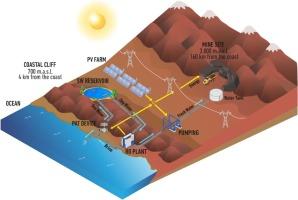可持续性设计:为采矿作业提供水和能源的一体化抽水反渗透系统
IF 9.9
1区 工程技术
Q1 ENERGY & FUELS
引用次数: 0
摘要
采矿业是水和能源密集型行业,由于依赖化石燃料,对环境造成了严重影响。将抽水蓄能与以可再生能源为动力的反渗透设备结合起来,可以提高采矿业的可持续性。本研究利用设计方程、成本模型和全球敏感性分析,评估了为智利北部阿塔卡马沙漠的采矿业提供淡水和清洁能源的系统的可行性。这项研究的新颖之处在于开发了一个模型,该模型考虑到了为采矿作业实施这一综合系统所涉及的技术、经济和环境问题。研究结果表明,该系统供水和供能的平准化成本分别为 3.20 美元-m-3 和 87.04 美元-MWh-1。单独运行时,供水成本为 4.73 美元-立方米-3,能源成本为 48.96 美元-兆瓦时-1。当使用可再生能源而不是国家电网供电时,温室气体排放量从 660.58 千吨 CO2eq-y-1 减少到 143.16 千吨 CO2eq-y-1,使其成为一个具有竞争力的环保选择。全球敏感性分析表明,电力和钢材价格以及反渗透设备资本成本是对供水平准化成本影响最大的变量。同时,对能源供应的平准化成本影响最大的变量是光伏发电场的资本成本和运营成本,以及作为涡轮机设备的水泵的资本成本。因此,要大幅降低平准化成本,应重点关注这些变量。本文章由计算机程序翻译,如有差异,请以英文原文为准。

Design for sustainability: An integrated pumped hydro reverse osmosis system to supply water and energy for mining operations
The mining industry is water and energy-intensive and has significant environmental impacts due to its reliance on fossil fuels. Integrating pumped hydro energy storage with a reverse osmosis plant powered by renewables could improve its sustainability. The present study assesses the feasibility of implementing a system to supply fresh water and clean energy to the mining industry of the Atacama Desert in northern Chile, using design equations, cost models, and global sensitivity analysis. The novelty of the study consists in developing a model that considers the technical, economic, and environmental aspects of putting this integrated system for mining operations in place. The results show that the levelized costs of this system to supply water and energy reach 3.20 US$·m−3 and 87.04 US$·MWh−1, respectively. Operating separately, the costs are 4.73 US$·m−3 for water and 48.96 US$·MWh−1 for energy. When powered by renewable energy instead of the national grid, greenhouse gas emissions are reduced from 660.58 to 143.16 ktCO2eq·y-1, making it a competitive and environmentally friendly option. Global sensitivity analysis identified prices of electricity and steel, and the reverse osmosis plant capital cost as the variables exerting the strongest impact on the levelized cost of water supply. Meanwhile, for the levelized cost of energy supply, the variables exerting the strongest impact are the photovoltaic farm capital and operational cost, and the pump as a turbine device capital cost. Therefore, to achieve a substantial reduction in the levelized costs, efforts should focus on these variables.
求助全文
通过发布文献求助,成功后即可免费获取论文全文。
去求助
来源期刊

Energy Conversion and Management
工程技术-力学
CiteScore
19.00
自引率
11.50%
发文量
1304
审稿时长
17 days
期刊介绍:
The journal Energy Conversion and Management provides a forum for publishing original contributions and comprehensive technical review articles of interdisciplinary and original research on all important energy topics.
The topics considered include energy generation, utilization, conversion, storage, transmission, conservation, management and sustainability. These topics typically involve various types of energy such as mechanical, thermal, nuclear, chemical, electromagnetic, magnetic and electric. These energy types cover all known energy resources, including renewable resources (e.g., solar, bio, hydro, wind, geothermal and ocean energy), fossil fuels and nuclear resources.
 求助内容:
求助内容: 应助结果提醒方式:
应助结果提醒方式:


